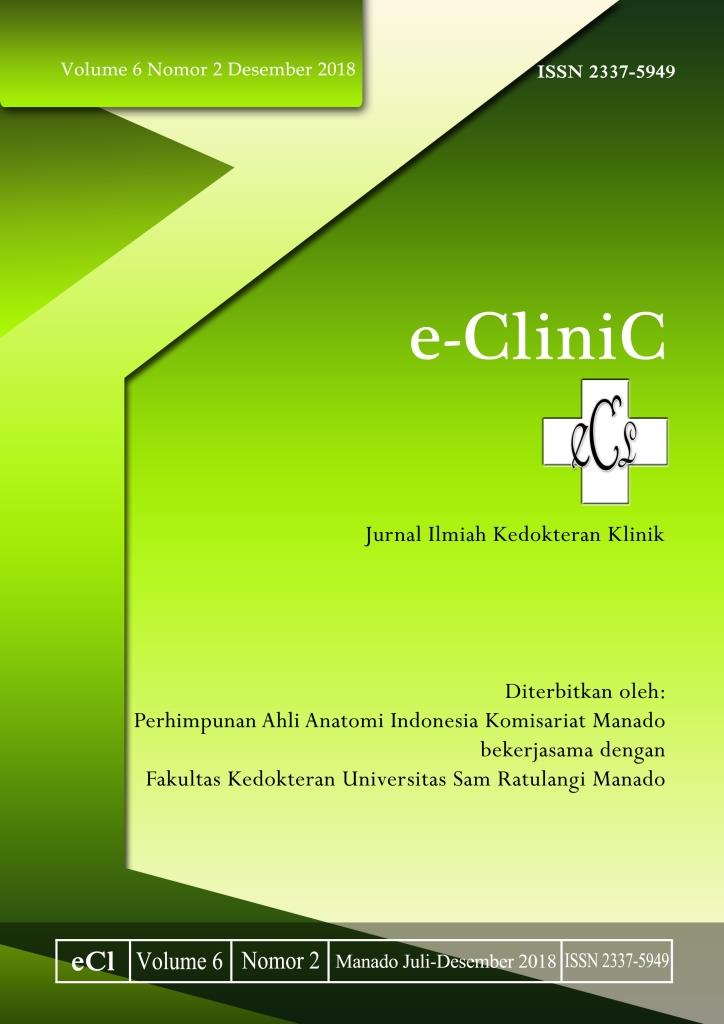Gambaran Penyakit Jantung Bawaan di Neonatal Intensive Care Unit RSUP Prof. Dr. R. D. Kandou Manado Periode 2013 - 2017
DOI:
https://doi.org/10.35790/ecl.v6i2.22124Abstract
Abstract: Congenital heart disease (CHD) is a structural heart defect that results from abnormal embryological heart development, or persistence of some parts of the fetal circulation at birth. Congenital heart disease is divided into two categories, namely non-cyanotic congenital heart disease and cyanotic congenital heart disease. Congenital heart disease is caused by interactions between predisposing exogenous factors and endogenous factors. This study was aimed to obtain the profile of CHD in the Neonatal Intensive Care Unit (NICU) of Prof. Dr. R. D. Kandou Hospital Manado in the period 2013 - 2017. This was a retrospective descriptive study using medical record data of patients suffering from CHD in NICU from 2013 to 2017. The results showed that there were 27 patients suffering from CHD consisting of 24 non-cyanotic CHD patients (88.89%) and 3 cyanotic CHD patients (11.11%), and the highest incidence was Atrial Septal Defect (ASD) as many as 17 babies (62.96%). Congenital heart disease was more common in males as many as 18 babies (66.67%). In this study, the clinical symptoms oftenly found was shortness of breath (48.15%) and the most common diagnosis was pneumonia (48.15%). Conclusion: The most common CHD was non-cyanotic CHD. The most commonly found defect was ASD. Clinical symptoms that often arised was shortness of breath, pneumonia was the most common comorbid diagnosis, and the dominant gender of CHD was male.
Keywords: non-cyanotic CHD, cyanotic CHD, atrial septal defect
Â
Abstrak: Penyakit jantung bawaan (PJB) merupakan defek jantung struktural yang terjadi akibat perkembangan jantung embriologis yang abnormal, atau persistensi dari beberapa bagian dari sirkulasi fetus saat lahir. Penyakit ini dibagi menjadi dua kategori yaitu penyakit jantung bawaan non sianosis dan yang sianosis. Penyakit jantung bawaan disebabkan oleh interaksi antara predisposisi faktor eksogen dan faktor endogen. Penelitian ini bertujuan untuk mendapatkan gambaran penyakit jantung bawaan di Neonatal Intensive Care Unit (NICU) RSUP Prof. Dr. R. D. Kandou Manado periode 2013-2017. Jenis penelitian ialah deskriptif retrospektif dengan menggunakan data rekam medik pasien yang menyandang penyakit jantung bawaan di NICU periode 2013-2017. Hasil penelitian mendapatkan dari 27 pasien dengan PJB, ditemukan PJB non sianotik berjumlah 24 bayi (88,89%) dan PJB sianotik berjumlah 3 bayi (11,11%) dengan angka kejadian terbanyak pada atrial septal defek (ASD) berjumlah 17 bayi (62,96%). Penyakit jantung bawaan paling banyak terjadi pada bayi yang berjenis kelamin laki-laki yaitu berjumlah 18 bayi (66,67%). Gejala klinis yang sering muncul ialah sesak napas (48,15%) dan diagnosis penyerta terbanyak yaitu pnemonia (48,15%). Simpulan: Penyakit jantung bawaan non sianosis merupakan diagnosis terbanyak, jenis ASD, dengan gejala klinis yang sering muncul yaitu sesak napas. Pneumonia merupakan diagnosis penyerta terbanyak. PJB tersering pada jenis kelamin laki-laki.
Kata kunci: PJB sianotik, PJB, non sianotik, atrial septal defek
Downloads
How to Cite
Issue
Section
License
COPYRIGHT
Authors who publish with this journal agree to the following terms:
Authors hold their copyright and grant this journal the privilege of first publication, with the work simultaneously licensed under a Creative Commons Attribution License that permits others to impart the work with an acknowledgment of the work's origin and initial publication by this journal.
Authors can enter into separate or additional contractual arrangements for the non-exclusive distribution of the journal's published version of the work (for example, post it to an institutional repository or publish it in a book), with an acknowledgment of its underlying publication in this journal.
Authors are permitted and encouraged to post their work online (for example, in institutional repositories or on their website) as it can lead to productive exchanges, as well as earlier and greater citation of the published work (See The Effect of Open Access).







